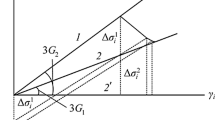Abstract
The possibility of predicting the reservoir rock location is shown on the basis of finite-element modeling of the volume stress-strain state of rock mass. To increase the calculation accuracy, this method procedure is improved with regard for the conjugation conditions of the stress field components at the interfaces.
Similar content being viewed by others
REFERENCES
L. A. Nazarova, “Modeling of volume stress fields in fault zones of the Earth's crust,” Dokl. RAN, 342,No. 6 (1995).
A. V. Leont'ev, L. A. Nazarova, and L. A. Nazarov, “Model representations of regional stress fields for the Altai-Sayan mountain region,” Fiz.-Tekh. Probl. Razrab. Polezn. Iskop., No. 4 (1996).
Yu. A. Kashnikov and S. G. Ashikhmin, “Rock movement calculation in mining oil deposits. Parts I and II,” Marksh. Vestn., Nos. 1–2 (1998).
Yu. A. Kashnikov, S. G. Ashikhmin, et al., “Geodynamic and geomechanical aspects of mining the hydrocarbon deposits in Western Siberia,” in: Proceedings of the 3rd International Working Conference on Geodynamic and Ecological Safety in Gas Production, Its Transportation, and Storage [in Russian], VNIMI, Saint Petersburg (2001).
V. O. Kaledin and V. P. Lastovetskii, “Mathematical modeling of the stress-strain state of rocks as applied to the oil-and gas-prospecting problems,” Geofiz., No. 3 (1999).
V. P. Lastovetskii, “Stress-strain state, its relation with the filtration rock properties and gravimetric field (by the example of Yurubchensk oil-gas condensate field),” Geol. Neft. Gaz., No. 5 (2001).
B. P. Sibiryakov, “Stress state of rocks in the vicinity of oil well (by the example of Riphean of Siberian platform),” Geol. Geofiz., 34,No. 9 (1993).
B. P. Sibiryakov and A. D. Zaikin, “Multiwave seismic prospecting and applied geodynamics in oil-and gas-bearing regions,” Geol. Geofiz., No. 5 (1994).
I. A. Garagash, V. N. Nikolaevskii, et al., “Deep-seated anomalies of crusted stresses in the zone of subsalt hydrocarbon deposits of North Caspian,” Dokl. RAN, 338,No. 3 (1994).
O. Zenkevich, Finite-Element Method in Engineering [in Russian], Mir, Moscow (1975).
N. P. Abovskii, N. P. Andreev, et al., Variational Principles of Elasticity and Shell Theories [in Russian], Nauka, Moscow (1978).
T. V. Burnysheva, “Variational statement of boundary-value problem of elasticity theory with regard for conjugation conditions at the interfaces,” in: Proceedings of the 5th All-Russian Scientific Conference on Boundary-Value Problems and Mathematical Modeling [in Russian], Branch of Kemerovo State University, Novokuznetsk (2002).
J. Oden, Finite Elements in Nonlinear Continuum Mechanics [Russian translation], Mir, Moscow (1976).
V. O. Kaledin, T. V. Burnysheva, and A. B. Tsvetkov, “Investigation into the stress-strain state of inhomogeneous rock massif during the action of mass forces,” Gorn. Inform. Analit. Byull., No. 1, MGGU, Moscow (2002).
A. S. Kosmodamianskii, Plane Problem of Elasticity Theory for the Plates with Holes, Notches, and Projections [in Russian], Vishcha Shkola, Kiev (1975).
A. E. Kontorovich, A. M. Izosimova, et al., “Geological structure and formation conditions of giant Yurubchensk-Tokhomsk zone of oil-and gas-accumulation in Upper Proterozoic of Siberian platform,” Geol. Geofiz., 37,No. 8 (1996).
V. A. Krinin and O. V. Gutina, “Nature and some structural peculiarities of reservoirs in Riphean sediments of the Yurubchensk deposit,” in: Geological Structure, Oil and Gas Content, Prospects of Mining Oil and Gas Deposits of Lower Angara region [in Russian], Krasnoyarskgeolkom, Krasnoyarsk (1996).
K. I. Bagrintseva, “Conditions of formation and properties of carbonate oil and gas reservoirs,” [in Russian], RGGU, Moscow (1999).
E. P. Koshchuk, A. S. Efimov, et al., “To the problem of exploration optimization in Kuyumbinsk area according to the results of seismic prospecting in 1997–1999,” in: Geology and Mineral Resources of Central Siberia [in Russian], issue 1, Krasnoyarsk Research Institute of Geology and Mineral Raw Materials, Krasnoyarsk (2000).
V. V. Kharakhinov, V. N. Nesterov, et al., “New data on geological structure of Yurubchensk-Tokhomsk zone of oil-and gas-accumulation,” Geol. Neft. Gaz., No. 5 (2000).
M. V. Kurlenya, A. V. Leont'ev, and S. N. Popov, “Development of the hydraulic fracturing method for investigation of stress state of the rock mass,” Fiz.-Tekh. Probl. Razrab. Polezn. Iskop., No. 1 (1994).
M. V. Kurlenya and V. N. Popov, Theoretical Foundations of Stress Determination in Rocks [in Russian], Nauka, Novosibirsk (1983).
V. M. Proskuryakov and A. S. Blyakhman, Seismic Methods of Investigation into the Stress State of Rock Mass [in Russia], Nedra, Moscow (1983).
Methodological Recommendations for Studying the Stress-Strain State of Rocks at Different Stages of Geological Prospecting Process [in Russian], All-Union Research Institute of Geosystems, Moscow (1987).
Author information
Authors and Affiliations
Rights and permissions
About this article
Cite this article
Kaledin, V.O., Burnysheva, T.V. & Lastovetskii, V.P. Mathematical Modeling of Stress Fields for the Problems of Prospecting and Mining the Hydrocarbon Deposits. Journal of Mining Science 38, 544–557 (2002). https://doi.org/10.1023/A:1024930024460
Issue Date:
DOI: https://doi.org/10.1023/A:1024930024460




